Financial and Economic Literacy Report: UK Market Analysis
VerifiedAdded on 2020/06/06
|13
|3442
|77
Report
AI Summary
This report provides a detailed analysis of financial and economic concepts relevant to managers. It begins by examining market structures, multinational corporations, small and medium enterprises, and growth strategies, applying economic theories to real-world scenarios, including a local UK high street shop. The report then explores demand, supply, and the impact of the Bank of England's monetary policy on the UK housing market. Macroeconomic indicators such as GDP and inflation are analyzed, along with relevant economic theories. The report also delves into the application of leverage and current account management. Finally, it includes a financial ratio analysis of Tesco Plc and an investment appraisal using Net Present Value (NPV), concluding with a synthesis of the key findings and implications for managerial decision-making. The report emphasizes the importance of economic concepts for business and national economic health.
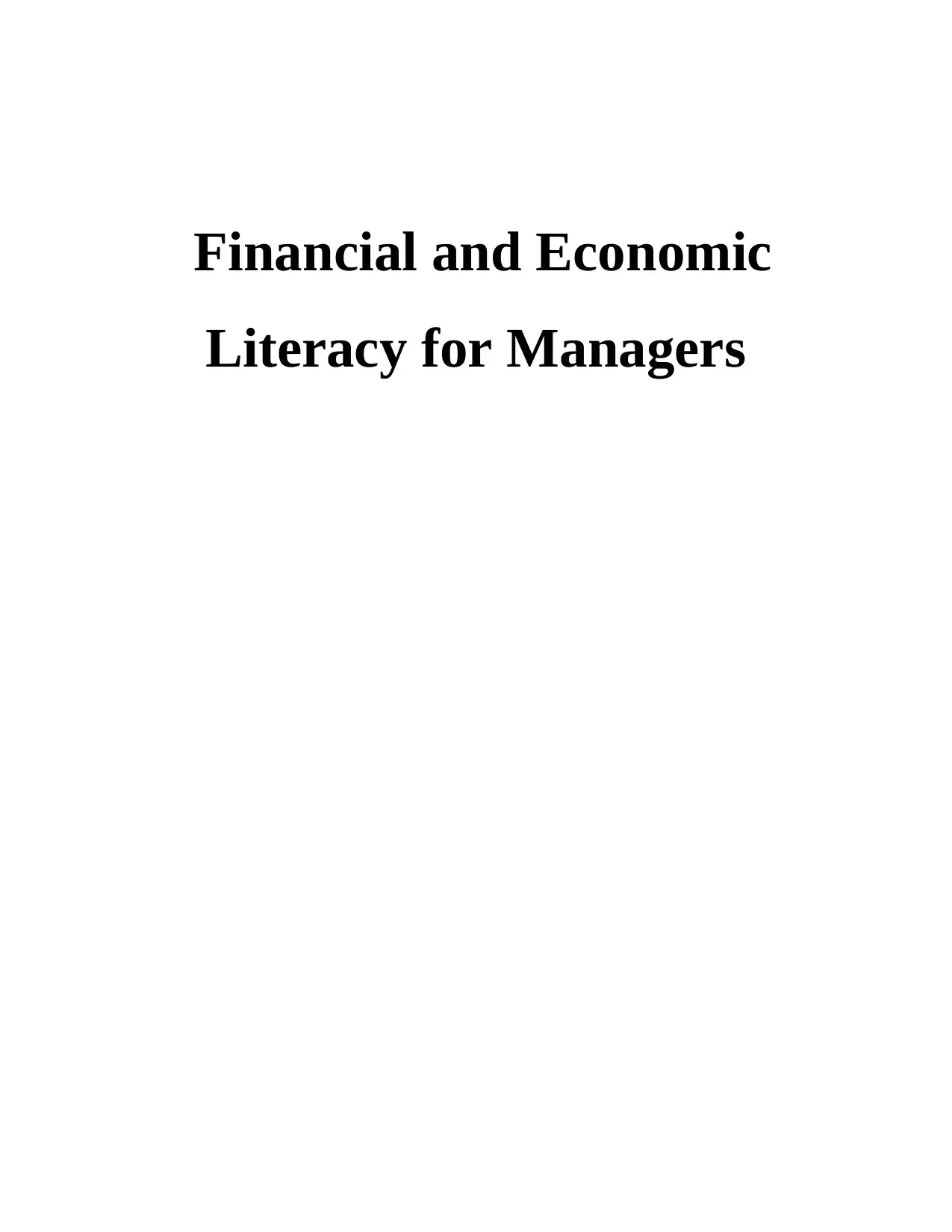
Financial and Economic
Literacy for Managers
Literacy for Managers
Paraphrase This Document
Need a fresh take? Get an instant paraphrase of this document with our AI Paraphraser
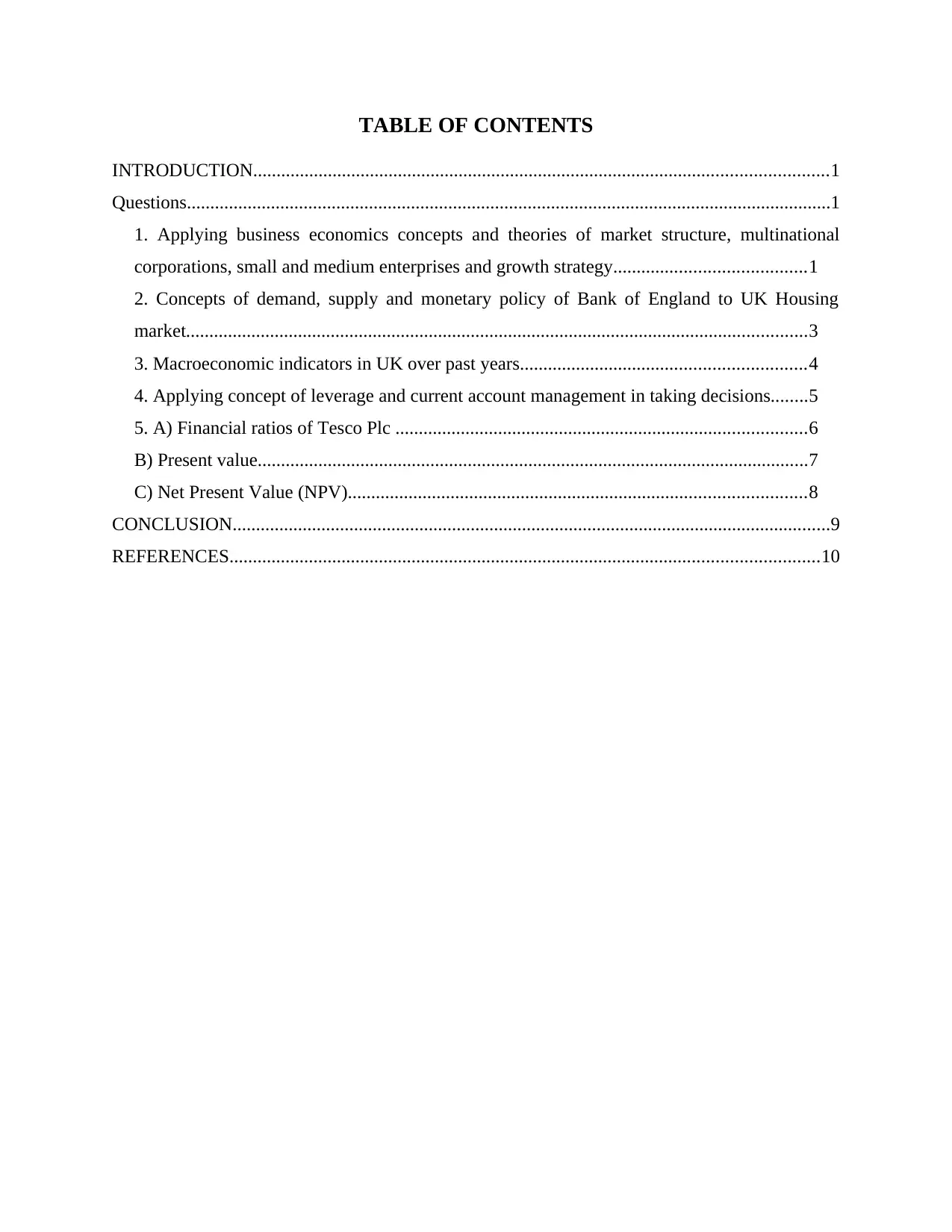
TABLE OF CONTENTS
INTRODUCTION...........................................................................................................................1
Questions..........................................................................................................................................1
1. Applying business economics concepts and theories of market structure, multinational
corporations, small and medium enterprises and growth strategy.........................................1
2. Concepts of demand, supply and monetary policy of Bank of England to UK Housing
market.....................................................................................................................................3
3. Macroeconomic indicators in UK over past years.............................................................4
4. Applying concept of leverage and current account management in taking decisions........5
5. A) Financial ratios of Tesco Plc ........................................................................................6
B) Present value......................................................................................................................7
C) Net Present Value (NPV)..................................................................................................8
CONCLUSION................................................................................................................................9
REFERENCES..............................................................................................................................10
INTRODUCTION...........................................................................................................................1
Questions..........................................................................................................................................1
1. Applying business economics concepts and theories of market structure, multinational
corporations, small and medium enterprises and growth strategy.........................................1
2. Concepts of demand, supply and monetary policy of Bank of England to UK Housing
market.....................................................................................................................................3
3. Macroeconomic indicators in UK over past years.............................................................4
4. Applying concept of leverage and current account management in taking decisions........5
5. A) Financial ratios of Tesco Plc ........................................................................................6
B) Present value......................................................................................................................7
C) Net Present Value (NPV)..................................................................................................8
CONCLUSION................................................................................................................................9
REFERENCES..............................................................................................................................10
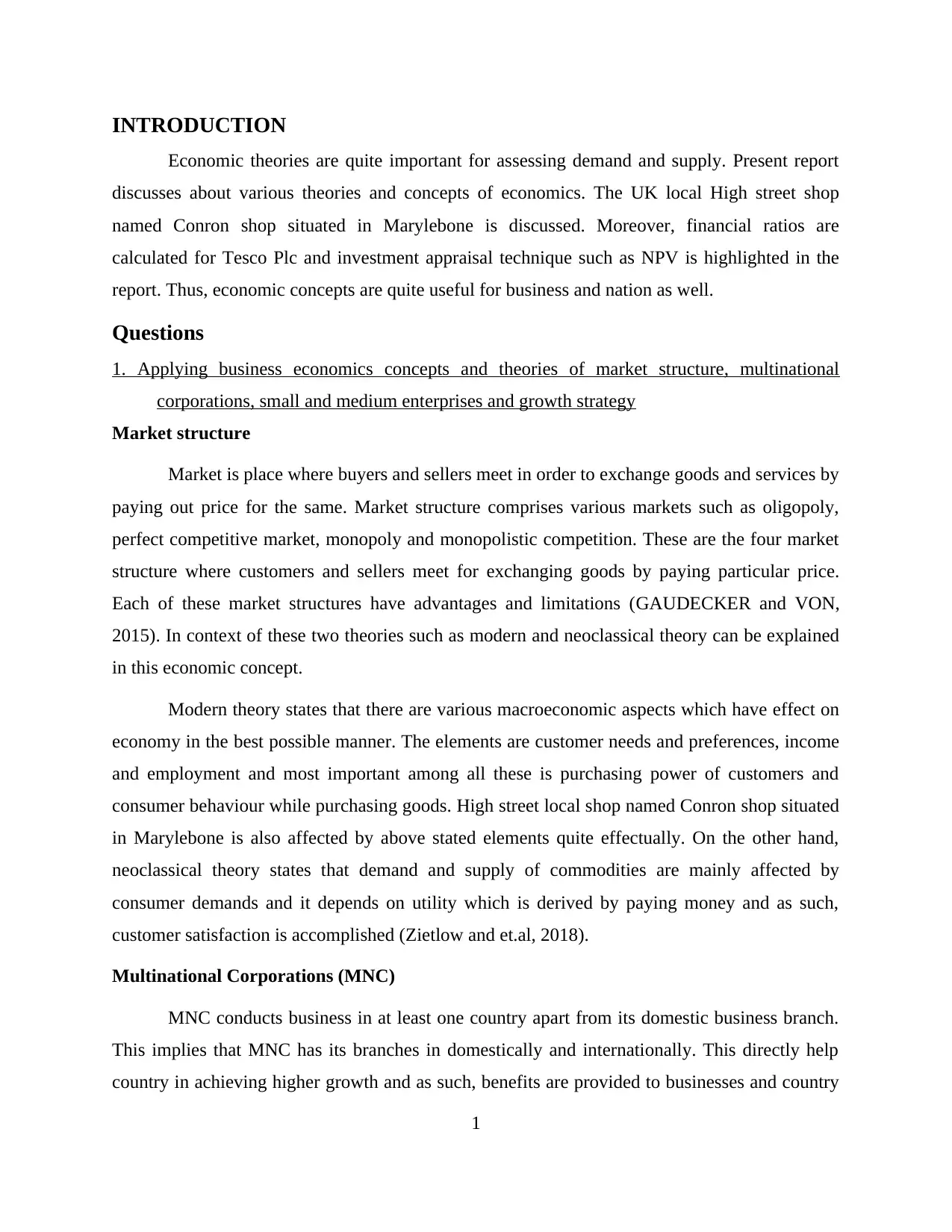
INTRODUCTION
Economic theories are quite important for assessing demand and supply. Present report
discusses about various theories and concepts of economics. The UK local High street shop
named Conron shop situated in Marylebone is discussed. Moreover, financial ratios are
calculated for Tesco Plc and investment appraisal technique such as NPV is highlighted in the
report. Thus, economic concepts are quite useful for business and nation as well.
Questions
1. Applying business economics concepts and theories of market structure, multinational
corporations, small and medium enterprises and growth strategy
Market structure
Market is place where buyers and sellers meet in order to exchange goods and services by
paying out price for the same. Market structure comprises various markets such as oligopoly,
perfect competitive market, monopoly and monopolistic competition. These are the four market
structure where customers and sellers meet for exchanging goods by paying particular price.
Each of these market structures have advantages and limitations (GAUDECKER and VON,
2015). In context of these two theories such as modern and neoclassical theory can be explained
in this economic concept.
Modern theory states that there are various macroeconomic aspects which have effect on
economy in the best possible manner. The elements are customer needs and preferences, income
and employment and most important among all these is purchasing power of customers and
consumer behaviour while purchasing goods. High street local shop named Conron shop situated
in Marylebone is also affected by above stated elements quite effectually. On the other hand,
neoclassical theory states that demand and supply of commodities are mainly affected by
consumer demands and it depends on utility which is derived by paying money and as such,
customer satisfaction is accomplished (Zietlow and et.al, 2018).
Multinational Corporations (MNC)
MNC conducts business in at least one country apart from its domestic business branch.
This implies that MNC has its branches in domestically and internationally. This directly help
country in achieving higher growth and as such, benefits are provided to businesses and country
1
Economic theories are quite important for assessing demand and supply. Present report
discusses about various theories and concepts of economics. The UK local High street shop
named Conron shop situated in Marylebone is discussed. Moreover, financial ratios are
calculated for Tesco Plc and investment appraisal technique such as NPV is highlighted in the
report. Thus, economic concepts are quite useful for business and nation as well.
Questions
1. Applying business economics concepts and theories of market structure, multinational
corporations, small and medium enterprises and growth strategy
Market structure
Market is place where buyers and sellers meet in order to exchange goods and services by
paying out price for the same. Market structure comprises various markets such as oligopoly,
perfect competitive market, monopoly and monopolistic competition. These are the four market
structure where customers and sellers meet for exchanging goods by paying particular price.
Each of these market structures have advantages and limitations (GAUDECKER and VON,
2015). In context of these two theories such as modern and neoclassical theory can be explained
in this economic concept.
Modern theory states that there are various macroeconomic aspects which have effect on
economy in the best possible manner. The elements are customer needs and preferences, income
and employment and most important among all these is purchasing power of customers and
consumer behaviour while purchasing goods. High street local shop named Conron shop situated
in Marylebone is also affected by above stated elements quite effectually. On the other hand,
neoclassical theory states that demand and supply of commodities are mainly affected by
consumer demands and it depends on utility which is derived by paying money and as such,
customer satisfaction is accomplished (Zietlow and et.al, 2018).
Multinational Corporations (MNC)
MNC conducts business in at least one country apart from its domestic business branch.
This implies that MNC has its branches in domestically and internationally. This directly help
country in achieving higher growth and as such, benefits are provided to businesses and country
1
⊘ This is a preview!⊘
Do you want full access?
Subscribe today to unlock all pages.

Trusted by 1+ million students worldwide
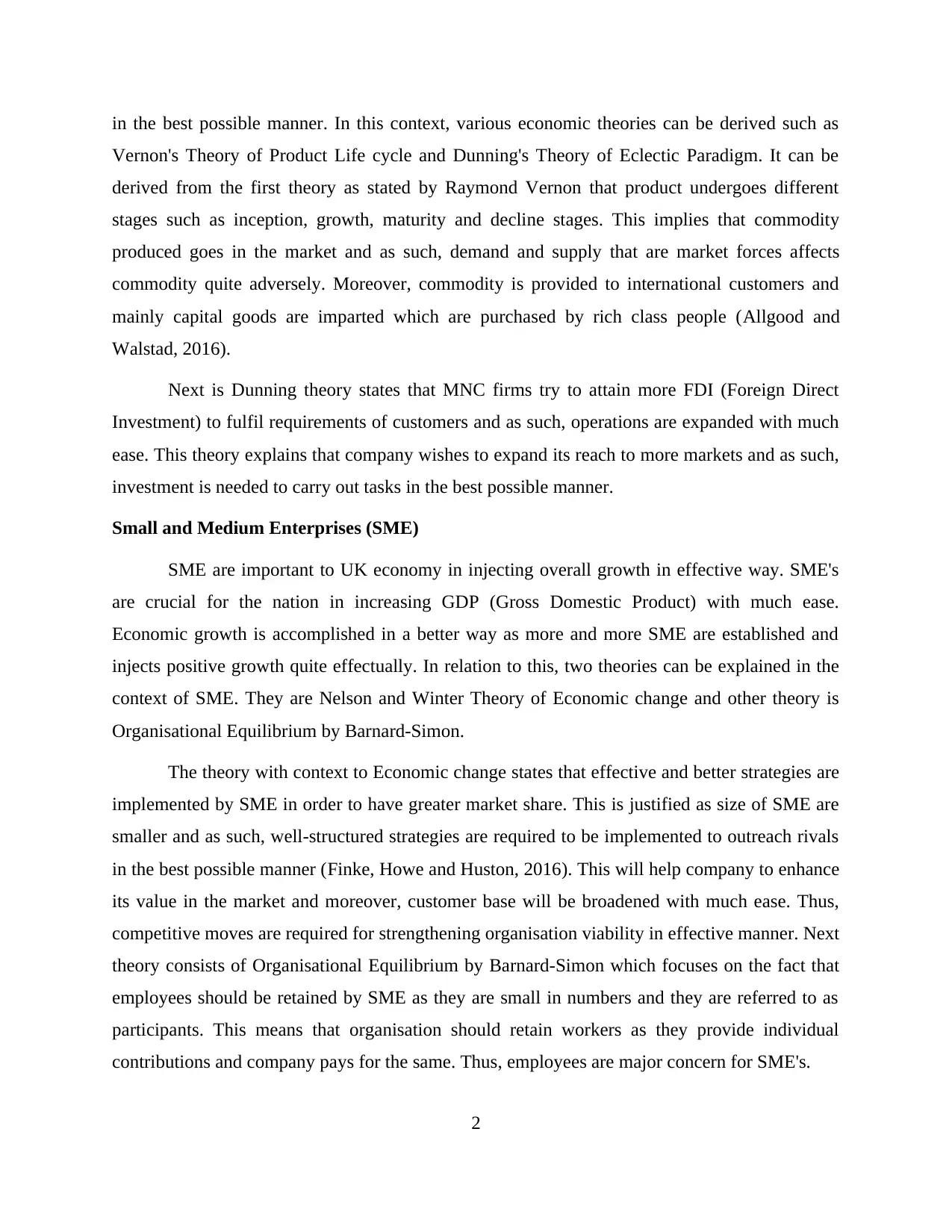
in the best possible manner. In this context, various economic theories can be derived such as
Vernon's Theory of Product Life cycle and Dunning's Theory of Eclectic Paradigm. It can be
derived from the first theory as stated by Raymond Vernon that product undergoes different
stages such as inception, growth, maturity and decline stages. This implies that commodity
produced goes in the market and as such, demand and supply that are market forces affects
commodity quite adversely. Moreover, commodity is provided to international customers and
mainly capital goods are imparted which are purchased by rich class people (Allgood and
Walstad, 2016).
Next is Dunning theory states that MNC firms try to attain more FDI (Foreign Direct
Investment) to fulfil requirements of customers and as such, operations are expanded with much
ease. This theory explains that company wishes to expand its reach to more markets and as such,
investment is needed to carry out tasks in the best possible manner.
Small and Medium Enterprises (SME)
SME are important to UK economy in injecting overall growth in effective way. SME's
are crucial for the nation in increasing GDP (Gross Domestic Product) with much ease.
Economic growth is accomplished in a better way as more and more SME are established and
injects positive growth quite effectually. In relation to this, two theories can be explained in the
context of SME. They are Nelson and Winter Theory of Economic change and other theory is
Organisational Equilibrium by Barnard-Simon.
The theory with context to Economic change states that effective and better strategies are
implemented by SME in order to have greater market share. This is justified as size of SME are
smaller and as such, well-structured strategies are required to be implemented to outreach rivals
in the best possible manner (Finke, Howe and Huston, 2016). This will help company to enhance
its value in the market and moreover, customer base will be broadened with much ease. Thus,
competitive moves are required for strengthening organisation viability in effective manner. Next
theory consists of Organisational Equilibrium by Barnard-Simon which focuses on the fact that
employees should be retained by SME as they are small in numbers and they are referred to as
participants. This means that organisation should retain workers as they provide individual
contributions and company pays for the same. Thus, employees are major concern for SME's.
2
Vernon's Theory of Product Life cycle and Dunning's Theory of Eclectic Paradigm. It can be
derived from the first theory as stated by Raymond Vernon that product undergoes different
stages such as inception, growth, maturity and decline stages. This implies that commodity
produced goes in the market and as such, demand and supply that are market forces affects
commodity quite adversely. Moreover, commodity is provided to international customers and
mainly capital goods are imparted which are purchased by rich class people (Allgood and
Walstad, 2016).
Next is Dunning theory states that MNC firms try to attain more FDI (Foreign Direct
Investment) to fulfil requirements of customers and as such, operations are expanded with much
ease. This theory explains that company wishes to expand its reach to more markets and as such,
investment is needed to carry out tasks in the best possible manner.
Small and Medium Enterprises (SME)
SME are important to UK economy in injecting overall growth in effective way. SME's
are crucial for the nation in increasing GDP (Gross Domestic Product) with much ease.
Economic growth is accomplished in a better way as more and more SME are established and
injects positive growth quite effectually. In relation to this, two theories can be explained in the
context of SME. They are Nelson and Winter Theory of Economic change and other theory is
Organisational Equilibrium by Barnard-Simon.
The theory with context to Economic change states that effective and better strategies are
implemented by SME in order to have greater market share. This is justified as size of SME are
smaller and as such, well-structured strategies are required to be implemented to outreach rivals
in the best possible manner (Finke, Howe and Huston, 2016). This will help company to enhance
its value in the market and moreover, customer base will be broadened with much ease. Thus,
competitive moves are required for strengthening organisation viability in effective manner. Next
theory consists of Organisational Equilibrium by Barnard-Simon which focuses on the fact that
employees should be retained by SME as they are small in numbers and they are referred to as
participants. This means that organisation should retain workers as they provide individual
contributions and company pays for the same. Thus, employees are major concern for SME's.
2
Paraphrase This Document
Need a fresh take? Get an instant paraphrase of this document with our AI Paraphraser
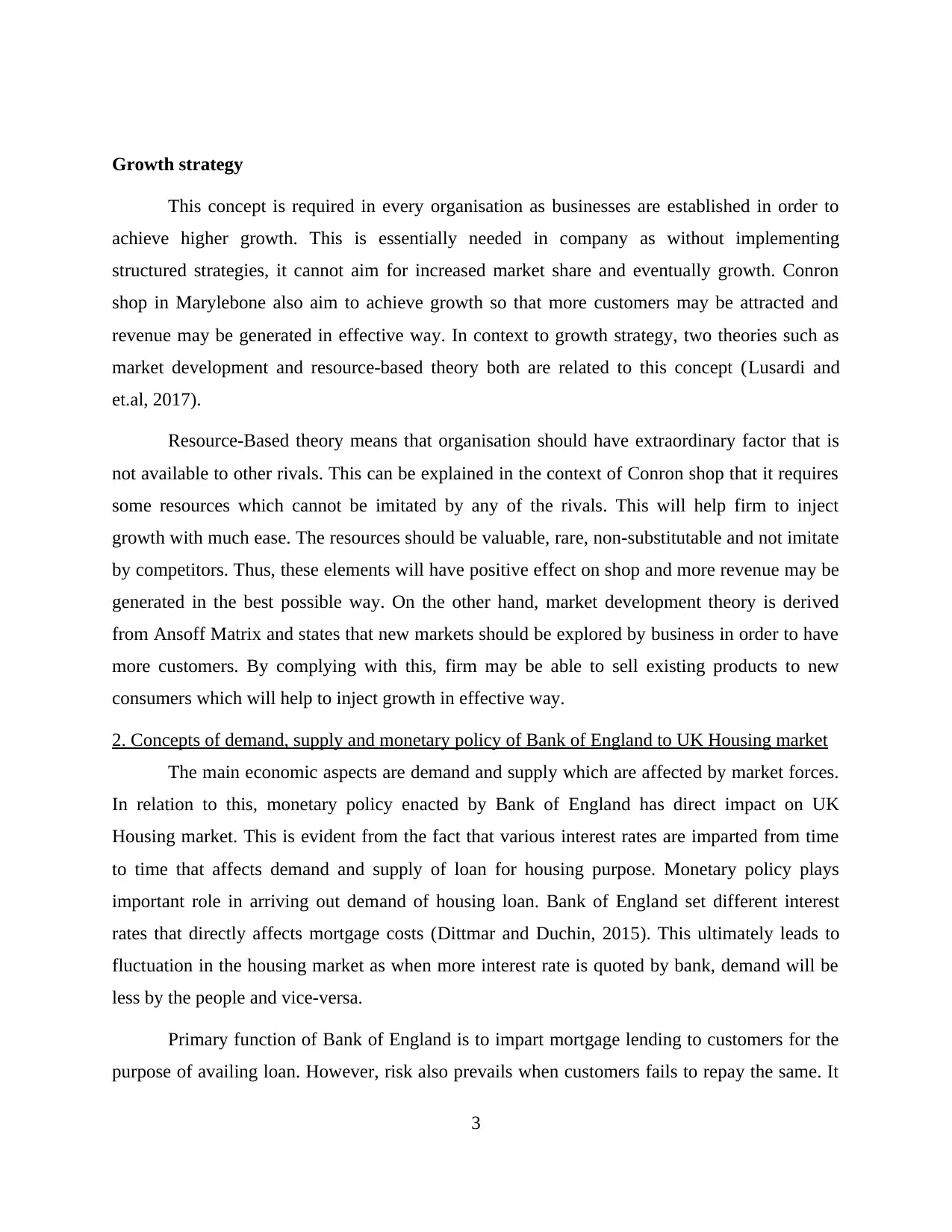
Growth strategy
This concept is required in every organisation as businesses are established in order to
achieve higher growth. This is essentially needed in company as without implementing
structured strategies, it cannot aim for increased market share and eventually growth. Conron
shop in Marylebone also aim to achieve growth so that more customers may be attracted and
revenue may be generated in effective way. In context to growth strategy, two theories such as
market development and resource-based theory both are related to this concept (Lusardi and
et.al, 2017).
Resource-Based theory means that organisation should have extraordinary factor that is
not available to other rivals. This can be explained in the context of Conron shop that it requires
some resources which cannot be imitated by any of the rivals. This will help firm to inject
growth with much ease. The resources should be valuable, rare, non-substitutable and not imitate
by competitors. Thus, these elements will have positive effect on shop and more revenue may be
generated in the best possible way. On the other hand, market development theory is derived
from Ansoff Matrix and states that new markets should be explored by business in order to have
more customers. By complying with this, firm may be able to sell existing products to new
consumers which will help to inject growth in effective way.
2. Concepts of demand, supply and monetary policy of Bank of England to UK Housing market
The main economic aspects are demand and supply which are affected by market forces.
In relation to this, monetary policy enacted by Bank of England has direct impact on UK
Housing market. This is evident from the fact that various interest rates are imparted from time
to time that affects demand and supply of loan for housing purpose. Monetary policy plays
important role in arriving out demand of housing loan. Bank of England set different interest
rates that directly affects mortgage costs (Dittmar and Duchin, 2015). This ultimately leads to
fluctuation in the housing market as when more interest rate is quoted by bank, demand will be
less by the people and vice-versa.
Primary function of Bank of England is to impart mortgage lending to customers for the
purpose of availing loan. However, risk also prevails when customers fails to repay the same. It
3
This concept is required in every organisation as businesses are established in order to
achieve higher growth. This is essentially needed in company as without implementing
structured strategies, it cannot aim for increased market share and eventually growth. Conron
shop in Marylebone also aim to achieve growth so that more customers may be attracted and
revenue may be generated in effective way. In context to growth strategy, two theories such as
market development and resource-based theory both are related to this concept (Lusardi and
et.al, 2017).
Resource-Based theory means that organisation should have extraordinary factor that is
not available to other rivals. This can be explained in the context of Conron shop that it requires
some resources which cannot be imitated by any of the rivals. This will help firm to inject
growth with much ease. The resources should be valuable, rare, non-substitutable and not imitate
by competitors. Thus, these elements will have positive effect on shop and more revenue may be
generated in the best possible way. On the other hand, market development theory is derived
from Ansoff Matrix and states that new markets should be explored by business in order to have
more customers. By complying with this, firm may be able to sell existing products to new
consumers which will help to inject growth in effective way.
2. Concepts of demand, supply and monetary policy of Bank of England to UK Housing market
The main economic aspects are demand and supply which are affected by market forces.
In relation to this, monetary policy enacted by Bank of England has direct impact on UK
Housing market. This is evident from the fact that various interest rates are imparted from time
to time that affects demand and supply of loan for housing purpose. Monetary policy plays
important role in arriving out demand of housing loan. Bank of England set different interest
rates that directly affects mortgage costs (Dittmar and Duchin, 2015). This ultimately leads to
fluctuation in the housing market as when more interest rate is quoted by bank, demand will be
less by the people and vice-versa.
Primary function of Bank of England is to impart mortgage lending to customers for the
purpose of availing loan. However, risk also prevails when customers fails to repay the same. It
3
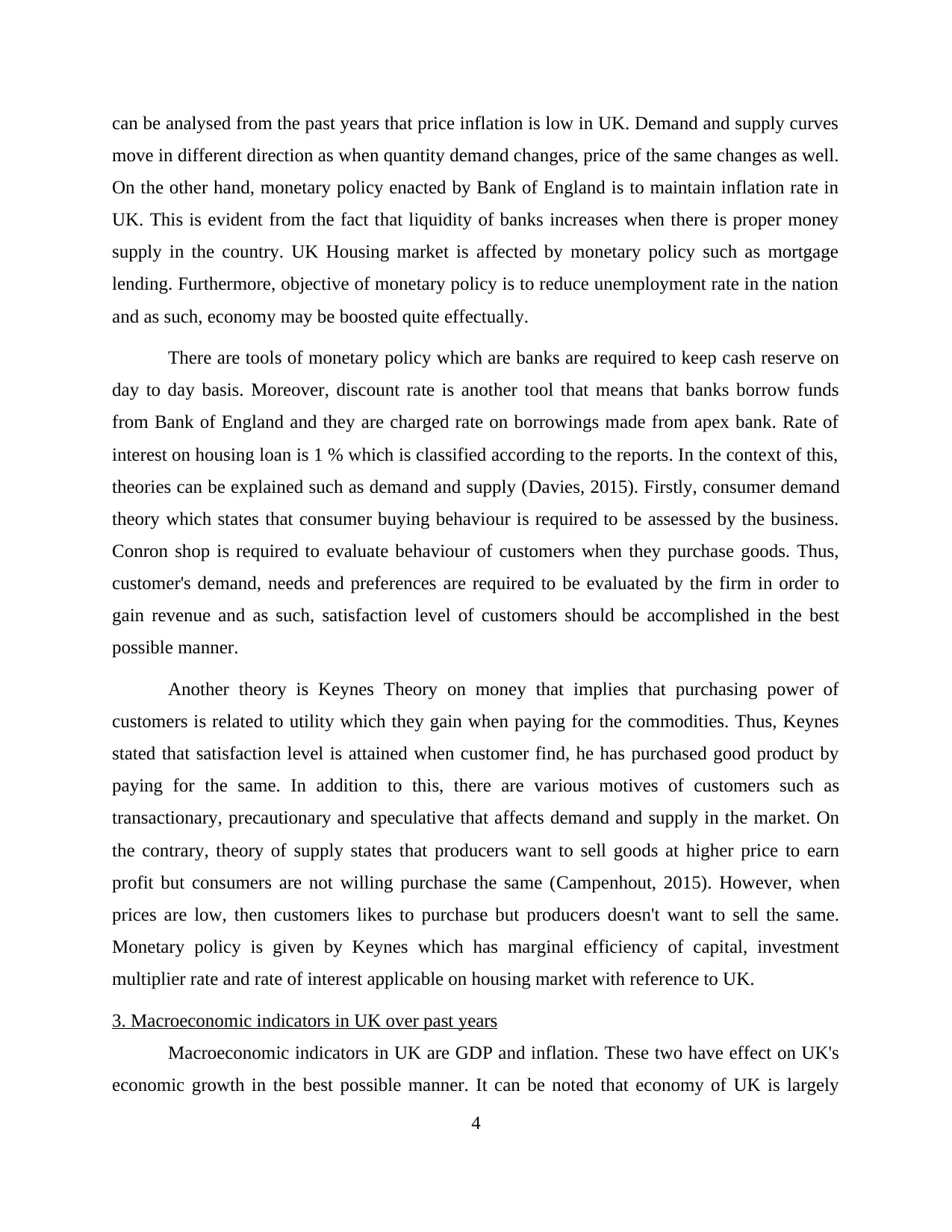
can be analysed from the past years that price inflation is low in UK. Demand and supply curves
move in different direction as when quantity demand changes, price of the same changes as well.
On the other hand, monetary policy enacted by Bank of England is to maintain inflation rate in
UK. This is evident from the fact that liquidity of banks increases when there is proper money
supply in the country. UK Housing market is affected by monetary policy such as mortgage
lending. Furthermore, objective of monetary policy is to reduce unemployment rate in the nation
and as such, economy may be boosted quite effectually.
There are tools of monetary policy which are banks are required to keep cash reserve on
day to day basis. Moreover, discount rate is another tool that means that banks borrow funds
from Bank of England and they are charged rate on borrowings made from apex bank. Rate of
interest on housing loan is 1 % which is classified according to the reports. In the context of this,
theories can be explained such as demand and supply (Davies, 2015). Firstly, consumer demand
theory which states that consumer buying behaviour is required to be assessed by the business.
Conron shop is required to evaluate behaviour of customers when they purchase goods. Thus,
customer's demand, needs and preferences are required to be evaluated by the firm in order to
gain revenue and as such, satisfaction level of customers should be accomplished in the best
possible manner.
Another theory is Keynes Theory on money that implies that purchasing power of
customers is related to utility which they gain when paying for the commodities. Thus, Keynes
stated that satisfaction level is attained when customer find, he has purchased good product by
paying for the same. In addition to this, there are various motives of customers such as
transactionary, precautionary and speculative that affects demand and supply in the market. On
the contrary, theory of supply states that producers want to sell goods at higher price to earn
profit but consumers are not willing purchase the same (Campenhout, 2015). However, when
prices are low, then customers likes to purchase but producers doesn't want to sell the same.
Monetary policy is given by Keynes which has marginal efficiency of capital, investment
multiplier rate and rate of interest applicable on housing market with reference to UK.
3. Macroeconomic indicators in UK over past years
Macroeconomic indicators in UK are GDP and inflation. These two have effect on UK's
economic growth in the best possible manner. It can be noted that economy of UK is largely
4
move in different direction as when quantity demand changes, price of the same changes as well.
On the other hand, monetary policy enacted by Bank of England is to maintain inflation rate in
UK. This is evident from the fact that liquidity of banks increases when there is proper money
supply in the country. UK Housing market is affected by monetary policy such as mortgage
lending. Furthermore, objective of monetary policy is to reduce unemployment rate in the nation
and as such, economy may be boosted quite effectually.
There are tools of monetary policy which are banks are required to keep cash reserve on
day to day basis. Moreover, discount rate is another tool that means that banks borrow funds
from Bank of England and they are charged rate on borrowings made from apex bank. Rate of
interest on housing loan is 1 % which is classified according to the reports. In the context of this,
theories can be explained such as demand and supply (Davies, 2015). Firstly, consumer demand
theory which states that consumer buying behaviour is required to be assessed by the business.
Conron shop is required to evaluate behaviour of customers when they purchase goods. Thus,
customer's demand, needs and preferences are required to be evaluated by the firm in order to
gain revenue and as such, satisfaction level of customers should be accomplished in the best
possible manner.
Another theory is Keynes Theory on money that implies that purchasing power of
customers is related to utility which they gain when paying for the commodities. Thus, Keynes
stated that satisfaction level is attained when customer find, he has purchased good product by
paying for the same. In addition to this, there are various motives of customers such as
transactionary, precautionary and speculative that affects demand and supply in the market. On
the contrary, theory of supply states that producers want to sell goods at higher price to earn
profit but consumers are not willing purchase the same (Campenhout, 2015). However, when
prices are low, then customers likes to purchase but producers doesn't want to sell the same.
Monetary policy is given by Keynes which has marginal efficiency of capital, investment
multiplier rate and rate of interest applicable on housing market with reference to UK.
3. Macroeconomic indicators in UK over past years
Macroeconomic indicators in UK are GDP and inflation. These two have effect on UK's
economic growth in the best possible manner. It can be noted that economy of UK is largely
4
⊘ This is a preview!⊘
Do you want full access?
Subscribe today to unlock all pages.

Trusted by 1+ million students worldwide
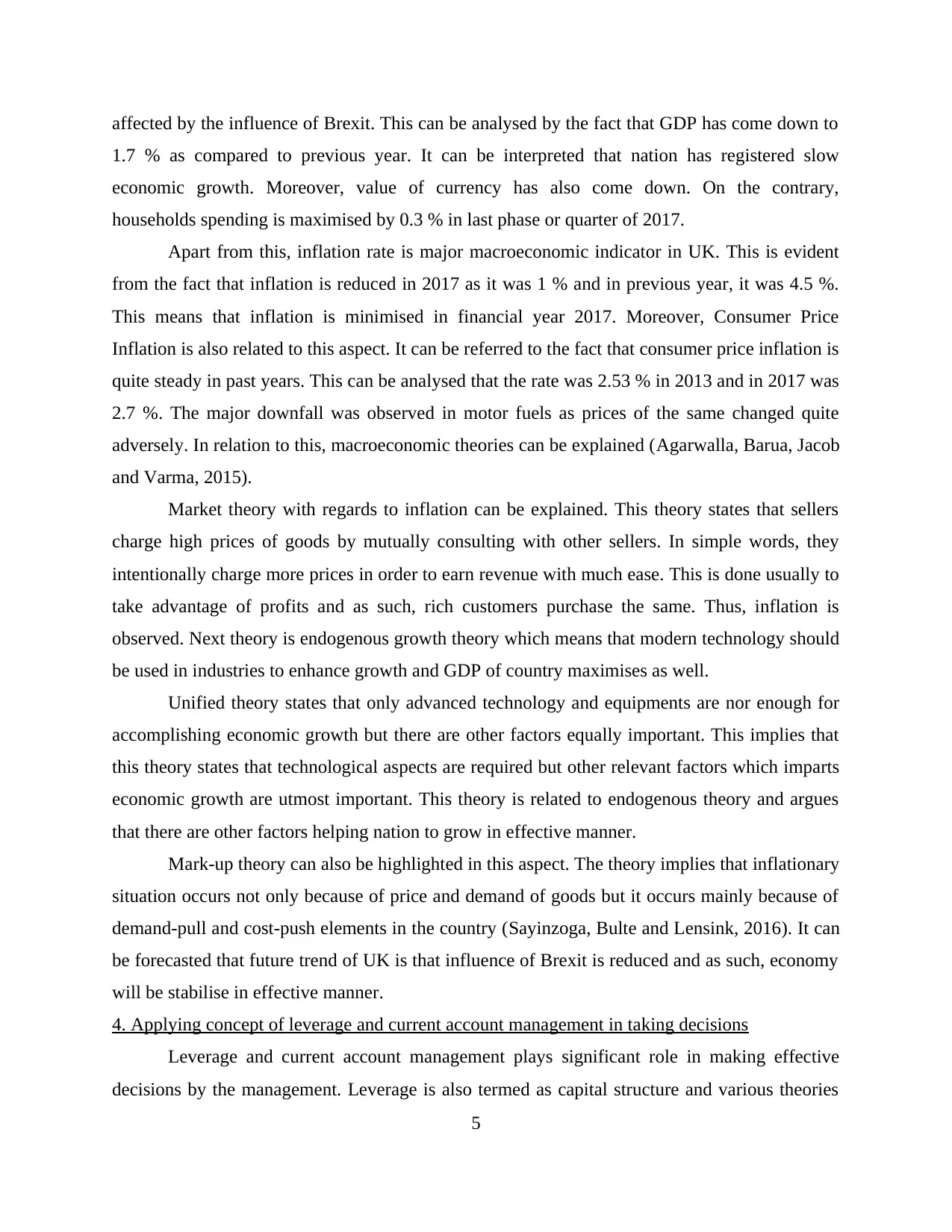
affected by the influence of Brexit. This can be analysed by the fact that GDP has come down to
1.7 % as compared to previous year. It can be interpreted that nation has registered slow
economic growth. Moreover, value of currency has also come down. On the contrary,
households spending is maximised by 0.3 % in last phase or quarter of 2017.
Apart from this, inflation rate is major macroeconomic indicator in UK. This is evident
from the fact that inflation is reduced in 2017 as it was 1 % and in previous year, it was 4.5 %.
This means that inflation is minimised in financial year 2017. Moreover, Consumer Price
Inflation is also related to this aspect. It can be referred to the fact that consumer price inflation is
quite steady in past years. This can be analysed that the rate was 2.53 % in 2013 and in 2017 was
2.7 %. The major downfall was observed in motor fuels as prices of the same changed quite
adversely. In relation to this, macroeconomic theories can be explained (Agarwalla, Barua, Jacob
and Varma, 2015).
Market theory with regards to inflation can be explained. This theory states that sellers
charge high prices of goods by mutually consulting with other sellers. In simple words, they
intentionally charge more prices in order to earn revenue with much ease. This is done usually to
take advantage of profits and as such, rich customers purchase the same. Thus, inflation is
observed. Next theory is endogenous growth theory which means that modern technology should
be used in industries to enhance growth and GDP of country maximises as well.
Unified theory states that only advanced technology and equipments are nor enough for
accomplishing economic growth but there are other factors equally important. This implies that
this theory states that technological aspects are required but other relevant factors which imparts
economic growth are utmost important. This theory is related to endogenous theory and argues
that there are other factors helping nation to grow in effective manner.
Mark-up theory can also be highlighted in this aspect. The theory implies that inflationary
situation occurs not only because of price and demand of goods but it occurs mainly because of
demand-pull and cost-push elements in the country (Sayinzoga, Bulte and Lensink, 2016). It can
be forecasted that future trend of UK is that influence of Brexit is reduced and as such, economy
will be stabilise in effective manner.
4. Applying concept of leverage and current account management in taking decisions
Leverage and current account management plays significant role in making effective
decisions by the management. Leverage is also termed as capital structure and various theories
5
1.7 % as compared to previous year. It can be interpreted that nation has registered slow
economic growth. Moreover, value of currency has also come down. On the contrary,
households spending is maximised by 0.3 % in last phase or quarter of 2017.
Apart from this, inflation rate is major macroeconomic indicator in UK. This is evident
from the fact that inflation is reduced in 2017 as it was 1 % and in previous year, it was 4.5 %.
This means that inflation is minimised in financial year 2017. Moreover, Consumer Price
Inflation is also related to this aspect. It can be referred to the fact that consumer price inflation is
quite steady in past years. This can be analysed that the rate was 2.53 % in 2013 and in 2017 was
2.7 %. The major downfall was observed in motor fuels as prices of the same changed quite
adversely. In relation to this, macroeconomic theories can be explained (Agarwalla, Barua, Jacob
and Varma, 2015).
Market theory with regards to inflation can be explained. This theory states that sellers
charge high prices of goods by mutually consulting with other sellers. In simple words, they
intentionally charge more prices in order to earn revenue with much ease. This is done usually to
take advantage of profits and as such, rich customers purchase the same. Thus, inflation is
observed. Next theory is endogenous growth theory which means that modern technology should
be used in industries to enhance growth and GDP of country maximises as well.
Unified theory states that only advanced technology and equipments are nor enough for
accomplishing economic growth but there are other factors equally important. This implies that
this theory states that technological aspects are required but other relevant factors which imparts
economic growth are utmost important. This theory is related to endogenous theory and argues
that there are other factors helping nation to grow in effective manner.
Mark-up theory can also be highlighted in this aspect. The theory implies that inflationary
situation occurs not only because of price and demand of goods but it occurs mainly because of
demand-pull and cost-push elements in the country (Sayinzoga, Bulte and Lensink, 2016). It can
be forecasted that future trend of UK is that influence of Brexit is reduced and as such, economy
will be stabilise in effective manner.
4. Applying concept of leverage and current account management in taking decisions
Leverage and current account management plays significant role in making effective
decisions by the management. Leverage is also termed as capital structure and various theories
5
Paraphrase This Document
Need a fresh take? Get an instant paraphrase of this document with our AI Paraphraser

can be enumerated in this context. Starting with Net income approach which states that WACC
(Weighted Average Cost of Capital) should be reduced in order to maximise firm's value in the
best possible manner. WACC includes preferred stock, long-term loans etc. In relation to this,
this theory proposed by Durand means that firm should use more of debt in capital structure and
as such, firm's value can be maximised. This is evident from the fact that equity capital is costlier
than debt and as such, business should use less of it.
The net income approach means that Conron shop should use less of equity which will
automatically reduce WACC and value will be enhanced. Furthermore, it is also provided that by
implementing this theory, management is able to have balanced capital structure (Capital
Structure Theory – Net Income Approach, 2018). Next theory of leverage is MM (Modiglani and
Miller) approach which argues that reducing WACC is not sufficient for enhancing value of firm
and as such, there are other factors which help company to maximise value. With regard to this,
future earnings of firm leads to maximise value. Thus, this theory clarifies that business has to
earn in order to maximise its value in the market.
Current account management is also important in taking enhanced decisions in the best
possible way. There are two theories which can be stated in this context such as Chaos and
Contingency theory (Ali, Rahman and Bakar, 2015). Chaos theory states that change occurs in
the company and as such, business should be ready for the change and comply with the same and
achieve goals in the best possible manner. On the other hand, Contingency theory states that no
formal procedure prevails and as such, management is required to take decision on the basis of
situations. Thus, these two theories help to manage current account quite effectually.
5. A) Financial ratios of Tesco Plc
Tesco Plc for the year 2015 and 2016
Particulars Formula 2016 2015
Profitability ratios
Net profit ratio Net income / sales 0.25 -9.22
6
(Weighted Average Cost of Capital) should be reduced in order to maximise firm's value in the
best possible manner. WACC includes preferred stock, long-term loans etc. In relation to this,
this theory proposed by Durand means that firm should use more of debt in capital structure and
as such, firm's value can be maximised. This is evident from the fact that equity capital is costlier
than debt and as such, business should use less of it.
The net income approach means that Conron shop should use less of equity which will
automatically reduce WACC and value will be enhanced. Furthermore, it is also provided that by
implementing this theory, management is able to have balanced capital structure (Capital
Structure Theory – Net Income Approach, 2018). Next theory of leverage is MM (Modiglani and
Miller) approach which argues that reducing WACC is not sufficient for enhancing value of firm
and as such, there are other factors which help company to maximise value. With regard to this,
future earnings of firm leads to maximise value. Thus, this theory clarifies that business has to
earn in order to maximise its value in the market.
Current account management is also important in taking enhanced decisions in the best
possible way. There are two theories which can be stated in this context such as Chaos and
Contingency theory (Ali, Rahman and Bakar, 2015). Chaos theory states that change occurs in
the company and as such, business should be ready for the change and comply with the same and
achieve goals in the best possible manner. On the other hand, Contingency theory states that no
formal procedure prevails and as such, management is required to take decision on the basis of
situations. Thus, these two theories help to manage current account quite effectually.
5. A) Financial ratios of Tesco Plc
Tesco Plc for the year 2015 and 2016
Particulars Formula 2016 2015
Profitability ratios
Net profit ratio Net income / sales 0.25 -9.22
6
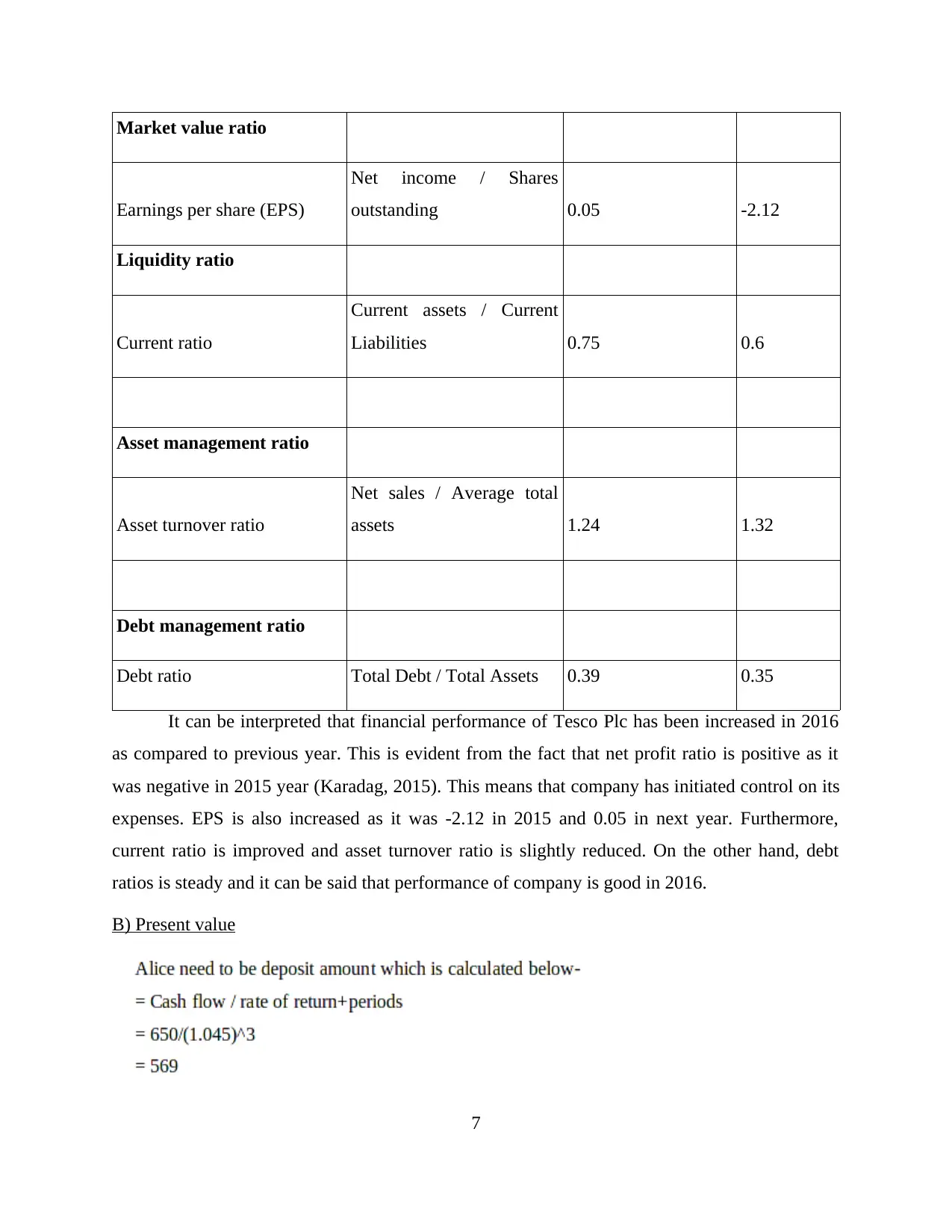
Market value ratio
Earnings per share (EPS)
Net income / Shares
outstanding 0.05 -2.12
Liquidity ratio
Current ratio
Current assets / Current
Liabilities 0.75 0.6
Asset management ratio
Asset turnover ratio
Net sales / Average total
assets 1.24 1.32
Debt management ratio
Debt ratio Total Debt / Total Assets 0.39 0.35
It can be interpreted that financial performance of Tesco Plc has been increased in 2016
as compared to previous year. This is evident from the fact that net profit ratio is positive as it
was negative in 2015 year (Karadag, 2015). This means that company has initiated control on its
expenses. EPS is also increased as it was -2.12 in 2015 and 0.05 in next year. Furthermore,
current ratio is improved and asset turnover ratio is slightly reduced. On the other hand, debt
ratios is steady and it can be said that performance of company is good in 2016.
B) Present value
7
Earnings per share (EPS)
Net income / Shares
outstanding 0.05 -2.12
Liquidity ratio
Current ratio
Current assets / Current
Liabilities 0.75 0.6
Asset management ratio
Asset turnover ratio
Net sales / Average total
assets 1.24 1.32
Debt management ratio
Debt ratio Total Debt / Total Assets 0.39 0.35
It can be interpreted that financial performance of Tesco Plc has been increased in 2016
as compared to previous year. This is evident from the fact that net profit ratio is positive as it
was negative in 2015 year (Karadag, 2015). This means that company has initiated control on its
expenses. EPS is also increased as it was -2.12 in 2015 and 0.05 in next year. Furthermore,
current ratio is improved and asset turnover ratio is slightly reduced. On the other hand, debt
ratios is steady and it can be said that performance of company is good in 2016.
B) Present value
7
⊘ This is a preview!⊘
Do you want full access?
Subscribe today to unlock all pages.

Trusted by 1+ million students worldwide
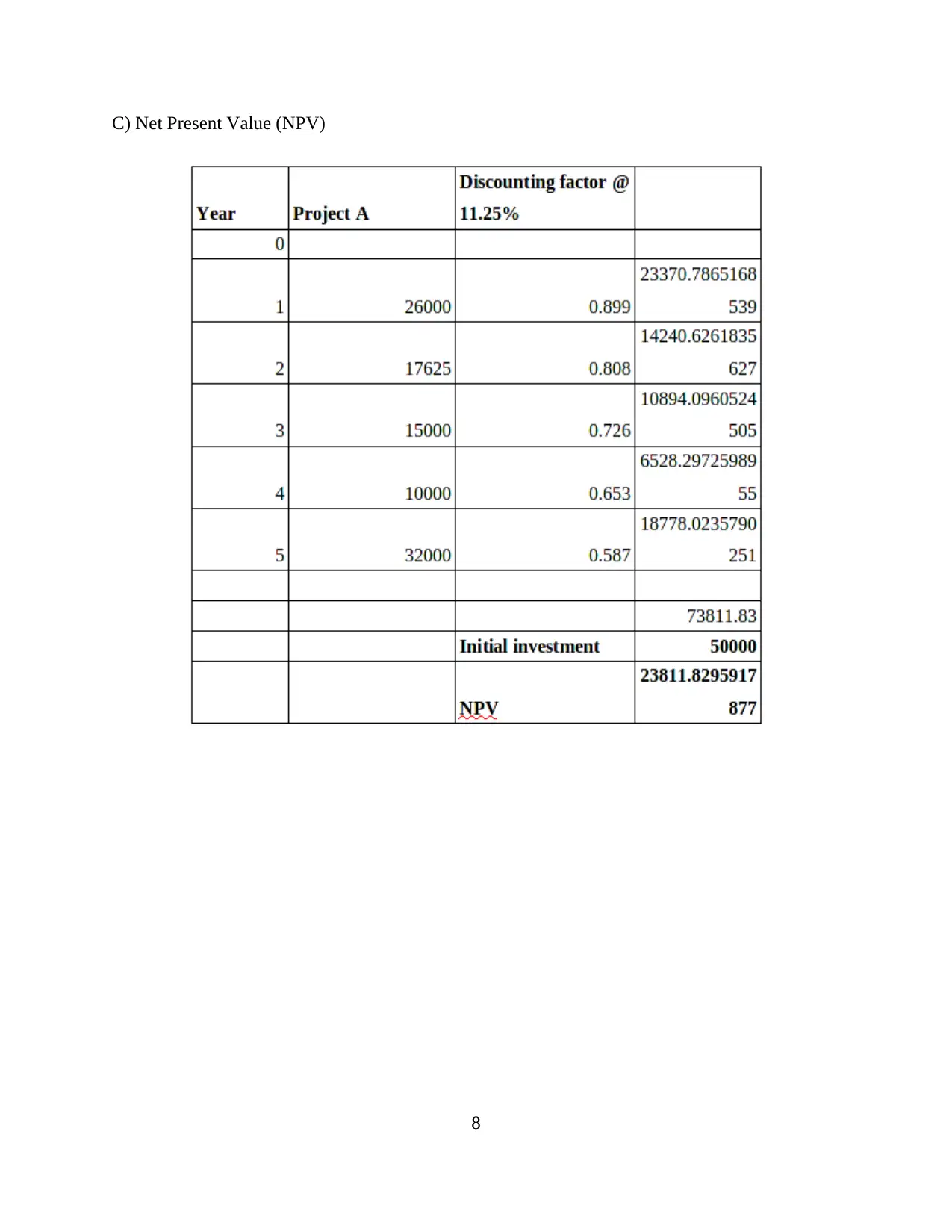
C) Net Present Value (NPV)
8
8
Paraphrase This Document
Need a fresh take? Get an instant paraphrase of this document with our AI Paraphraser
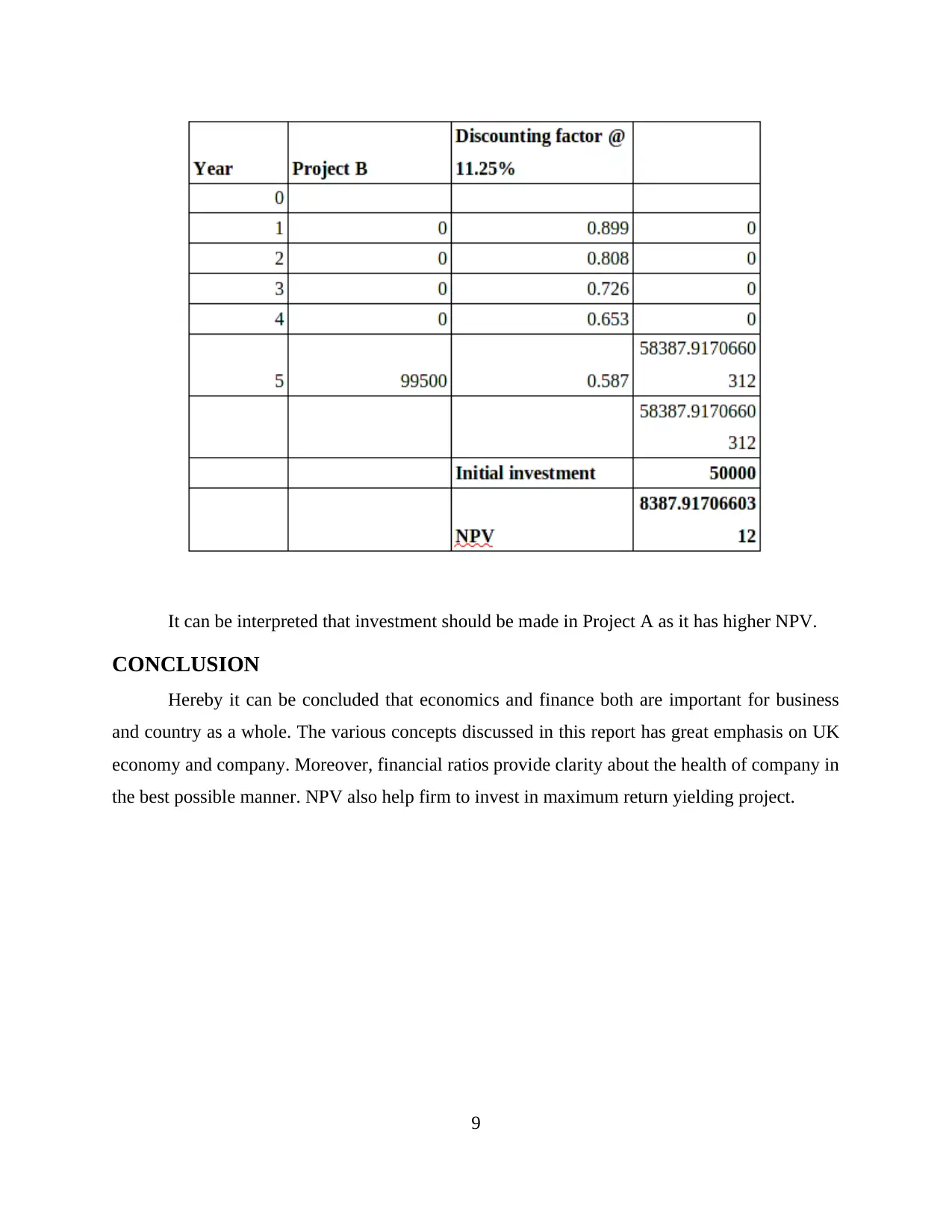
It can be interpreted that investment should be made in Project A as it has higher NPV.
CONCLUSION
Hereby it can be concluded that economics and finance both are important for business
and country as a whole. The various concepts discussed in this report has great emphasis on UK
economy and company. Moreover, financial ratios provide clarity about the health of company in
the best possible manner. NPV also help firm to invest in maximum return yielding project.
9
CONCLUSION
Hereby it can be concluded that economics and finance both are important for business
and country as a whole. The various concepts discussed in this report has great emphasis on UK
economy and company. Moreover, financial ratios provide clarity about the health of company in
the best possible manner. NPV also help firm to invest in maximum return yielding project.
9
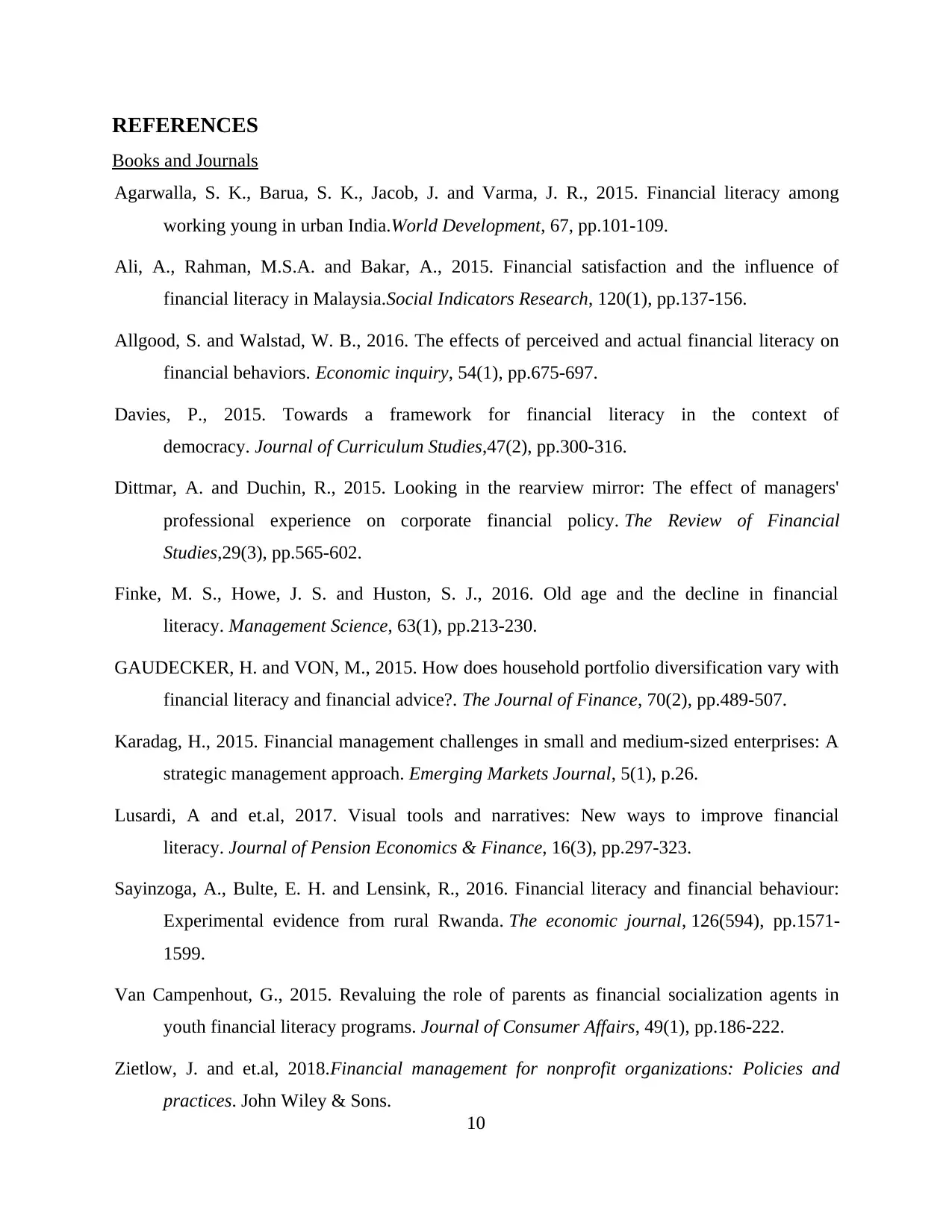
REFERENCES
Books and Journals
Agarwalla, S. K., Barua, S. K., Jacob, J. and Varma, J. R., 2015. Financial literacy among
working young in urban India.World Development, 67, pp.101-109.
Ali, A., Rahman, M.S.A. and Bakar, A., 2015. Financial satisfaction and the influence of
financial literacy in Malaysia.Social Indicators Research, 120(1), pp.137-156.
Allgood, S. and Walstad, W. B., 2016. The effects of perceived and actual financial literacy on
financial behaviors. Economic inquiry, 54(1), pp.675-697.
Davies, P., 2015. Towards a framework for financial literacy in the context of
democracy. Journal of Curriculum Studies,47(2), pp.300-316.
Dittmar, A. and Duchin, R., 2015. Looking in the rearview mirror: The effect of managers'
professional experience on corporate financial policy. The Review of Financial
Studies,29(3), pp.565-602.
Finke, M. S., Howe, J. S. and Huston, S. J., 2016. Old age and the decline in financial
literacy. Management Science, 63(1), pp.213-230.
GAUDECKER, H. and VON, M., 2015. How does household portfolio diversification vary with
financial literacy and financial advice?. The Journal of Finance, 70(2), pp.489-507.
Karadag, H., 2015. Financial management challenges in small and medium-sized enterprises: A
strategic management approach. Emerging Markets Journal, 5(1), p.26.
Lusardi, A and et.al, 2017. Visual tools and narratives: New ways to improve financial
literacy. Journal of Pension Economics & Finance, 16(3), pp.297-323.
Sayinzoga, A., Bulte, E. H. and Lensink, R., 2016. Financial literacy and financial behaviour:
Experimental evidence from rural Rwanda. The economic journal, 126(594), pp.1571-
1599.
Van Campenhout, G., 2015. Revaluing the role of parents as financial socialization agents in
youth financial literacy programs. Journal of Consumer Affairs, 49(1), pp.186-222.
Zietlow, J. and et.al, 2018.Financial management for nonprofit organizations: Policies and
practices. John Wiley & Sons.
10
Books and Journals
Agarwalla, S. K., Barua, S. K., Jacob, J. and Varma, J. R., 2015. Financial literacy among
working young in urban India.World Development, 67, pp.101-109.
Ali, A., Rahman, M.S.A. and Bakar, A., 2015. Financial satisfaction and the influence of
financial literacy in Malaysia.Social Indicators Research, 120(1), pp.137-156.
Allgood, S. and Walstad, W. B., 2016. The effects of perceived and actual financial literacy on
financial behaviors. Economic inquiry, 54(1), pp.675-697.
Davies, P., 2015. Towards a framework for financial literacy in the context of
democracy. Journal of Curriculum Studies,47(2), pp.300-316.
Dittmar, A. and Duchin, R., 2015. Looking in the rearview mirror: The effect of managers'
professional experience on corporate financial policy. The Review of Financial
Studies,29(3), pp.565-602.
Finke, M. S., Howe, J. S. and Huston, S. J., 2016. Old age and the decline in financial
literacy. Management Science, 63(1), pp.213-230.
GAUDECKER, H. and VON, M., 2015. How does household portfolio diversification vary with
financial literacy and financial advice?. The Journal of Finance, 70(2), pp.489-507.
Karadag, H., 2015. Financial management challenges in small and medium-sized enterprises: A
strategic management approach. Emerging Markets Journal, 5(1), p.26.
Lusardi, A and et.al, 2017. Visual tools and narratives: New ways to improve financial
literacy. Journal of Pension Economics & Finance, 16(3), pp.297-323.
Sayinzoga, A., Bulte, E. H. and Lensink, R., 2016. Financial literacy and financial behaviour:
Experimental evidence from rural Rwanda. The economic journal, 126(594), pp.1571-
1599.
Van Campenhout, G., 2015. Revaluing the role of parents as financial socialization agents in
youth financial literacy programs. Journal of Consumer Affairs, 49(1), pp.186-222.
Zietlow, J. and et.al, 2018.Financial management for nonprofit organizations: Policies and
practices. John Wiley & Sons.
10
⊘ This is a preview!⊘
Do you want full access?
Subscribe today to unlock all pages.

Trusted by 1+ million students worldwide
1 out of 13
Related Documents
Your All-in-One AI-Powered Toolkit for Academic Success.
+13062052269
info@desklib.com
Available 24*7 on WhatsApp / Email
![[object Object]](/_next/static/media/star-bottom.7253800d.svg)
Unlock your academic potential
Copyright © 2020–2025 A2Z Services. All Rights Reserved. Developed and managed by ZUCOL.





